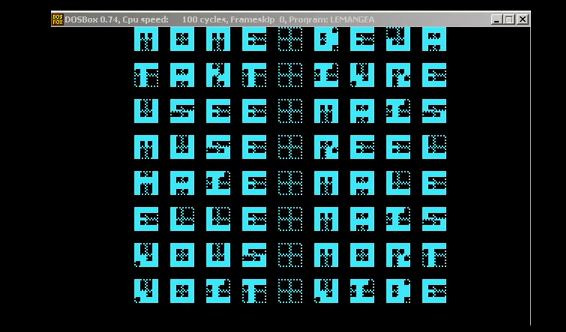Le mange-texte
Le Mange-Texte is a work by Jean-Marie Dutey that perfectly represents the esthetic of frustration. There are two versions of Le Mange-Texte: the original 1989 version (that was programmed and published in alire 0.1 and alire 1) and the 1994 version. When one starts to look at the black screen, squares appear, changing into the form of four letter words. The words gradually develop and the reader tries to decipher the letters in order to make sense of the unclear words (that can be read vertically, revealing the verses of the poem). The moment one tries to read the words in their proper context, the machine “eats” the text which transforms into different shapes. The color changes from blue to pink and instead of squares, one sees flowers, and the words change. Some words repeat, but the word “rose” (which can also be translated from original French into English as “pink”) appears, for example. Once again, the machine “eats” the words and the process repeats. It is difficult to read the text because the reader must try to distinguish the letters. With the speed of the changes and the machine's control, one experiences a sense of losing control and one can become frustrated. This work mixes temporal and spatial elements in that the page becomes non-transitory for several instants to become text, but it is a transitory text because it continues to change. (Source : Amy E. Laws) Do make sense of the words that appear and disappear so quickly, the reader can read them in two ways. One can concentrate on the individual words and try to make logical connections between them. For example, we can find subject-verb pairs ("elle voit" for example) or small adjectival phrases (example: "vous êtes snob"). However, the reader can see and retain even more words if he looks at the whole screen at once. With this approach, the eye is drawn to certain words that together, tell a more complete story. By reading the poem in this way, a theme begins to emerge. One can read sentences/fragments such as “très tard hier soir” (very late last night) and “sans rien dire” (without saying anything). We also see questions like “quel type êtes vous?” (what kind are you?) and “quel ciel vous sied?” (what heaven suits you?). Through these words, the image of a seductive woman appears. This fantasy is a principle theme of the poem, as it uses suggestive and sexual vocabulary. This image is strongly linked to the aesthetic of the piece. The idea of a powerful woman that metaphorically “devours” is physically represented by the program that “eats” the text as soon as it becomes readable. (Source: Erin Stigers)
Notes on the work's lability: "This work is a programmed animated text relying on graphic mutations. At first, the running of the work lasted 20 minutes and the legibility of the texts used to get the most of the graphic treatments that ruled its evolution. This work was then considered as a literary work. By 1994, due to the increasing speed of processors, the running time had been shortened to only a few minutes, which prevented anyone from reading the texts. The status of the work had changed. It was now considered as a graphic work. In 1994, the work was reprogrammed to its current form, in which the program adapts to the machine to some extent, so as to preserve a certain legibility. This solution does not completely correspond with the author’s initial intention, because some characteristics have not been preserved. It does not correspond to the preservation of a perceptive state either. It even relies on the fact that it is impossible to reach such preservation. Yet, this programming was performed with the author’s full consent. The change of status between the versions of 1989 and 1994 is directly linked to the intersemiotic behaviour of the work." (cf. Bootz et al. 2009)
Translation by Phillipe Bootz



